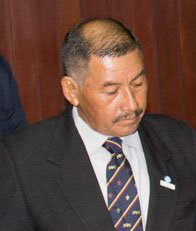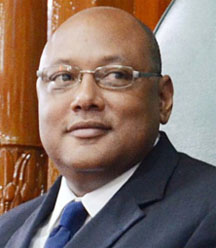The Guyana Geology and Mines Commission (GGMC) has granted permission for a miner to operate a river dredge near to Isseneru’s residential area, triggering a call by concerned residents for authorities to halt the operation and protect their rights.
Minister of Indigenous Peoples’ Affairs Sydney Allicock told Stabroek News on Thursday that the ministry is aware of the issue and it is one of several issues to be discussed when he meets Minister of Governance with responsibility for natural resources Raphael Trotman on Monday. He said he hopes that they would be able to come up with an immediate solution, while also looking for a long-term resolution.
Trotman did not respond to calls from Stabroek News nor did he respond to an email sent regarding the matter.

Isseneru resident Dwight Larson, in a letter published in Tuesday’s Stabroek News, highlighted the situation in hopes that the various state agencies and government ministries responsible for mining, indigenous affairs and legal affairs will take action. He said the GGMC on October 10th, 2015, issued permission to a miner to operate a cutter head river dredge in close proximity to Isseneru’s residential area, at Middle Mazaruni, Region Seven.
“This is blatant disrespect by GGMC and its officers to grant permission to this operation, knowing that this type of mining can cause huge environmental damage, health problems and loss of life,” he wrote.
GGMC Commissioner Rickford Vieira, when contacted, told Stabroek News that was on leave and overseas.
Risk
“This is a serious issue which needs an urgent response because it poses the risk of erosion and major damage to residential and government properties including the hydromet station, school and health facilities which are close to the area where this destructive mining operation is positioned. This is also a violation of Isseneru’s rights under Section 48 (1) of the Amerindian Act and section 112 of the Mining Act since no consultations were held between the GGMC, the dredge owner and the Isseneru Village Council,” Larson wrote in his letter.
“GGMC and the mining operation must be held accountable for any problems that arise. To make matters worse, this operation is creating a lot of noise both day and night and affecting residents, school children, the elderly and patients. The court rulings in favour of miners have given them ‘superman powers’ over Amerindian Village Councils thus creating an unfriendly and disrespectful environment for indigenous peoples where violations will thrive. This has to stop,” he added.

Larson called on government to strengthen legislation to ensure that human rights, including indigenous peoples’ rights, are guaranteed as fully as they appear to be for miners, loggers and land grabbers. He recalled that Trotman had said that no mining rights will be given on lands occupied by Amerindians and that the GGMC is not allowed to give out permits either to prospect or mine in any such area without the consent of the Amerindian community.
Larson requested that the relevant authorities investigate mining operations that are present without the consent of Amerindian Villages, such as at Isseneru, Kangaruma, Tassarene, Jawalla, Bara-mita, Chinese Landing, among others.
Allicock on Thursday identified issues facing some of those communities as being on the agenda for his discussions with Trotman. He said the ministry is aware of the issues faced and is taking the necessary steps to visit these communities and there is a schedule but finance is a hindrance.
Allicock also said that reform of the 2006 Amerindian Act is critical and there is a need to strengthen it. He pointed out that losses in several court cases indicate that the law is “not very helpful” when it comes to land and mining matters. He also acknowledged that the ministry needs to begin to look at setting up the Indigenous Peoples’ Lands Commission to tackle land issues.
Alarmed
Meanwhile, Amerindian Peoples Association (APA) programme assistant Laura George told Stabroek News that the organisation is alarmed that no substantial reform is imminent other than Trotman’s announcing that no permits will be issued on Amerindian lands. “There needs to be a holistic approach to this, since there are many precedents out of court decisions where they have cited legislation that do not recognise the rights of indigenous peoples to their lands, resources and territories, including waterways. GGMC and the courts have been using the laws that say all waterways belong to the State even though the Amerindian Act says there must be consultation and consent of an Amerindian community on any mining,” she said.
George declared that the biggest contradiction is that the highest law of the land, the Constitutional provision 149 G “is being violated over and over” and sections of the Mining Act 112 are also being violated.
She said that the state has an obligation to protect the rights of indigenous peoples and it is important that the state agencies recognise and respect all these provisions. She asserted that human rights are paramount over the economics and the destruction that these extractive activities cause. George added that the David Granger administration has also stated that mining permits and claims will be reviewed. She said that government needs to go beyond that and focus as well on the social, environmental and cultural impacts that mining have on indigenous peoples.
“That needs a study as well and work together with indigenous peoples, the miners and the state agencies to see how these can be minimised,” she said.
In the case of Isseneru, she said that the village complained to Vieira on two occasions about the miner and the first time, he was issued a cease-work order. However, he “came back more aggressively” and indicated that he could not be put out because he has the necessary papers and this time nothing has been done, she added.









